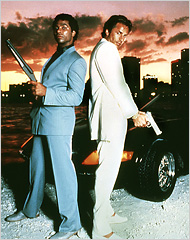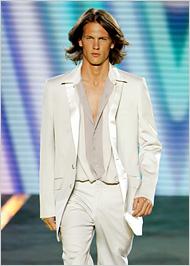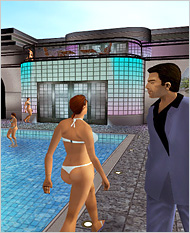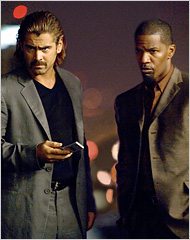Published: July 20, 2006
Some pop culture phenomena have the life span of a mayfly. Others have the staying power of a plutonium rod. The phenomenally popular “Miami Vice” flickered across screens for barely five seasons — 1984 to 1989 — on NBC, yet the effects of its influence on television, movies, music and most lastingly, of course, fashion, were so potent and unforeseeable that one can pick up their radioactive signals 17 years after the series shut down.
 The cop show lives on in reruns, on DVD and now in a new movie directed by the show’s executive producer, Michael Mann, which opens nationwide at the end of this month. While violent and stylized and packed with the gritty and hyper-real effects now obtainable through the miracle of computerization, “Miami Vice,” the movie, is set in the unfashionable present and thus unlikely to jump-start any trends.
The cop show lives on in reruns, on DVD and now in a new movie directed by the show’s executive producer, Michael Mann, which opens nationwide at the end of this month. While violent and stylized and packed with the gritty and hyper-real effects now obtainable through the miracle of computerization, “Miami Vice,” the movie, is set in the unfashionable present and thus unlikely to jump-start any trends.
True, each of its stars does his bit to add spin to the visual images originally conjured by Don Johnson and Philip Michael Thomas in the roles of James (Sonny) Crockett and Ricardo (Rico) Tubbs. But aside from a porn-star mustache that Colin Farrell, the new Crockett, wears, and the Malcolm X meets R. Kelly goatee Jamie Foxx affects in the movie, there is nothing stylistically to compare with the crazy subtropical brio of images from the 80’s TV show. Its Necco Wafer palette and ironic macho were ideal for an unsubtle era of big hair, big government and big bad gangsters hauling kilos for the Medellín cartel in cigarette boats backlighted by a Harvey Wallbanger sky.
“The way Michael Mann did the costumes has nothing to do with real cops,” said Jim Moore, the creative director of GQ magazine. “But it influenced everything we did at the time.”
 The extent to which the show played a part in the sartorial recasting of the American man is difficult to overestimate. Before “Miami Vice,” which was conceived as a cop show for the MTV generation, adult males were not often in the habit of wearing T-shirts under sports coats or shoes minus socks. Most guys without ties in the 1980’s would have been considered slobs or candidates for the unemployment line. Pastel-colored trousers were reserved for caddies, pastel-colored vehicles for pimps. Suits in the late Reagan era were still substantially lined and padded and as rigidly shaped as Barcaloungers, although with sleeves. Loose, crumpled garments were considered work wear for convicts or gigolos. Hardly anybody without a begging cup wore a straw hat.
The extent to which the show played a part in the sartorial recasting of the American man is difficult to overestimate. Before “Miami Vice,” which was conceived as a cop show for the MTV generation, adult males were not often in the habit of wearing T-shirts under sports coats or shoes minus socks. Most guys without ties in the 1980’s would have been considered slobs or candidates for the unemployment line. Pastel-colored trousers were reserved for caddies, pastel-colored vehicles for pimps. Suits in the late Reagan era were still substantially lined and padded and as rigidly shaped as Barcaloungers, although with sleeves. Loose, crumpled garments were considered work wear for convicts or gigolos. Hardly anybody without a begging cup wore a straw hat.
 Although it’s hard now to remember the radical statement these gestures once constituted, before “Miami Vice” few men except bank tellers rolled up their jacket sleeves, and about the only folks who flipped up their blazer collars were the singer George Michael or patrons in some Fort Lauderdale gentlemen-only bar. “It’s the first point in fashion history where you can really show a TV having that influence on fashion,” said Mr. Moore, adding that a two-day growth of beard before “Miami Vice” was a sure sign of a impending bumhood. “ ‘Miami Vice’ made stubble cool,” he said. It has stayed cool far too long, and this is something Mr. Mann should be required to answer for.
Although it’s hard now to remember the radical statement these gestures once constituted, before “Miami Vice” few men except bank tellers rolled up their jacket sleeves, and about the only folks who flipped up their blazer collars were the singer George Michael or patrons in some Fort Lauderdale gentlemen-only bar. “It’s the first point in fashion history where you can really show a TV having that influence on fashion,” said Mr. Moore, adding that a two-day growth of beard before “Miami Vice” was a sure sign of a impending bumhood. “ ‘Miami Vice’ made stubble cool,” he said. It has stayed cool far too long, and this is something Mr. Mann should be required to answer for.
When he orchestrated the look of the original show, Mr. Mann was venturing into stylistic territory already staked out by Italian designers, people like Gianni Versace, Gianfranco Ferré or Giorgio Armani, the man generally credited with introducing the world to the unconstructed suit — that is, without padding, a lining or internal stiffening. This might be as good a time as any to amend the old canard about Mr. Armani being the inventor of the floppy suit. It was long a staple of Neapolitan haberdashery, developed by tailors sent to London by wealthy patrons to apprentice on Savile Row. Being superior craftsmen, the tailors absorbed everything there was to know about British cuts and suit construction. Being Neapolitans, they blithely tossed out the window most of the knowledge they had acquired. It is generally too hot in Naples to dress like Bertie Wooster. But it is not too hot in Milan, where Mr. Armani adapted the look before wholesaling it to the world.
 “Miami Vice” may also have marked the earliest mainstream appearance of that indestructible cultural chimera, the metrosexual. “As tough as Sonny Crockett was meant to be,” the dude on a boat with a pet alligator named Elvis, “he still had the meticulously groomed scruff on his face and the pastel, linen-y sports jackets,” said Dan Peres, the editor of Details. “That all was certainly a part of the cultural moment that allowed men to embrace their vanity a little more openly.”
“Miami Vice” may also have marked the earliest mainstream appearance of that indestructible cultural chimera, the metrosexual. “As tough as Sonny Crockett was meant to be,” the dude on a boat with a pet alligator named Elvis, “he still had the meticulously groomed scruff on his face and the pastel, linen-y sports jackets,” said Dan Peres, the editor of Details. “That all was certainly a part of the cultural moment that allowed men to embrace their vanity a little more openly.”
It was their big weapons, of course, that gave the “Miami Vice” guys confidence enough to wear girly clothes and to moisturize. From the start the show unabashedly showcased the latest and scariest in armory, something it has in common with the new film, which rarely shows anyone unholstering a pistol when there’s a submachine gun around.
From the pilot episode, in which Crockett carried a sleek automatic, it was clear that the show sought to telegraph macho credibility and insider cool by swiping a tactic rappers were using successfully in their lyrical boasting, outgunning both everyday criminals and cops on the beat. So what if weapons experts considered the Bren Ten stainless steel pistol that was used for several early seasons to have been a dud, prone to malfunction and with a magazine that cost $100?
“The gun was a nice design, but you couldn’t find or afford the damn magazine,” said Garry James, a senior editor at Guns & Ammo. The Bren Ten was abandoned and replaced by a variety of other pistols, including one uncannily like a gold-plated model later found and looted from Saddam Hussein’s palace in Baghdad, and then seized by the British Customs and Excise Service early in 2003.
If the graphic and preening look of “Miami Vice” style made excellent joke fodder, visually easy to parody (as the cast of “Friends” did, in hilarious flashback), it also provided an enduring stylistic touchstone for consumers, who apparently never lost affection for Crockett and Tubbs.
Gamers still play “Grand Theft Auto: Vice City,” with its undercover officers looking like wonky virtual versions of Johnson and Thomas. Donatella Versace still designs men’s wear, as she did for the spring 2007 season shown recently in Milan, that modifies deftly, but only slightly, the defining elements of Pan-American style, circa Pablo Escobar and Manuel Noriega.
“Miami and ‘Miami Vice’ represented a magical time,” in the 1980’s, Ms. Versace said in an e-mail message, understatedly characterizing the era as colorful and “even excessive.” With her latest collection, Ms. Versace explained, “I returned to my roots and to a Miami that was very important to me in the late 80’s and early 90’s.”
Mr. Armani, too, plays games with the clichés of Latin macho; at his Emporio Armani presentation in June the designer sent models out wearing glue-on lip hair that looked a lot like the mustache Mr. Farrell has in the film.
With few exceptions, most purveyors of high-end design left “Miami Vice” behind a long time ago. Yet the effects of the show never really disappeared from the marketplace. “Our customer is a working guy who always wanted to look fashionable and set himself apart from the crowd,” said Neil Mulhall, the president of International Male, the mass market catalog clothier known for mesh pouch thongs and ruffled Byronic poets’ shirts. In its spring 2006 catalog, International Male offers a selection of suits in pink pastel linen and shirts of semi-sheer embroidered voile that could easily have been swiped from the set of “Miami Vice,” the television show or the film. “It’s a little bit forward and a little bit retro,” said Mr. Mulhall, neatly summing up the whole enterprise.